POLISH UNIFORMS
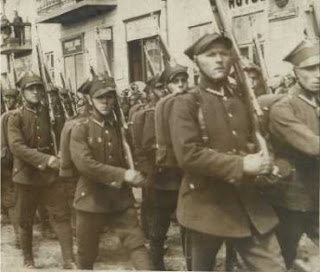 |
| POLISH INFANTRY WW2 |
Polish Infantry - Private (1939)
01 wz. 1939 "rogatywka" garrison cap
02 wz. 1937 "rogatywka" field cap
03 wz. 1937 steel helmet
04 wz. 1936 jacket
05 dog tag
06 WST wz. 1932 gas mask in a tarpaulin bag
07 personal dressing
08 leather ammo pouches
09 wz. 1933 breadbag
10 leather main belt
11 wz. 1938 canteen
12 wz. 1928 bayonet cover
13 folding shovel in a leather cover
14 wz. 1933 backpack with blanket
15 standard army biscuit
16 wz. 1931 mess kit
 |
| Polish troops (just before WW2) note French gas mask canisters |
18 owijacze - belts of cloth used instead of socks
19 boots
20 GR-31 grenade - frag
21 GR-31 grenade - concussion
22 7,92 mm Mauser 1898a rifle
23 7,92 mm ammo clips
24 wz.1924 bayonet
25 wire cutting shears
 |
| Polish Infantry 1939 |
 |
| Polish mountain infantry - Parade of Podhale Rifles circa 1936 |
Polish Soldiers of Podhale Rifles Regiment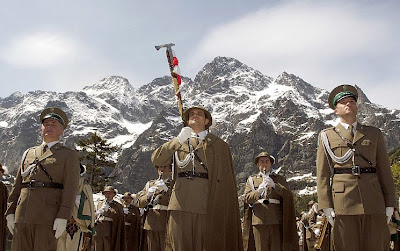 |
| Polish Soldiers of the Podhale Rifles Regiment -background High Tatras Mountains (notice the icepick?) |
 |
| Cloth insignia on field uniforms of Polish Podhale Rifles |
Es steht ein kleines, kleines Edelweiß
auf einer steilen, steilen Felsenhöh!
auf einer steilen, steilen Felsenhöh!
There is a small, small edelweiss
on a steep, steep rocky heights!
on a steep, steep rocky heights!
 |
| Highlander Cross badge worn on the collars of the Podhale Rifles Regiment until 1945 |
The traditional symbols of the Podhale Rifles regiment are the edelweiss and the Mountain Cross, the latter which has been part of the folk culture of the Polish mountain regions. It has no relation whatsoever to the Nazi swastikas of the NSDAP. In fact the Mountain Cross pre-dates the rise of the Nazi party.
 |
| Franciszek Kosibor in his uniform of Podhale Rifles-1939 Defensive War |
Polish Uhlan (1939)
01 wz. 1937 "rogatywka" field cap
02 wz. 1932 forage cap
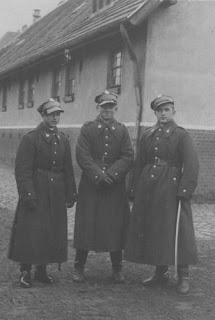 |
| Polish Uhlan |
04 wz. 1936 jacket
05 wz. 1931 canteen
06 dog tag
07 leather ammo pouches for Mauser ammo
08 main belt
09 RSC gas mask with canister
10 wz. 1924 bayonet cover
11 folding shovel in a leather cover
12 boots with spurs
13 wz. 1931 mess kit
14 personal dressing
15 wz. 1934 cavalry sabre
16 7,92mm Mauser 1898a rifle
17 wz. 1924 bayonet
18 7,92 mm ammo clips
19 fork + spoon kit
(Photo: Rogatywka with Polish coat of arms and pulkownik is the rank insignia of a Colonel.)
"Rogatywka" is the Polish name for an asymmetrical, peaked,four-pointed military cap. "Rog" is a derivative of the word and means "horn". No other army in the world has such a cap. There are two types of caps, the hardened version, indicated by "Mk.1935, is olive green with black peak and is worn in full gala uniforms; its rim color marks the unit type. The soft version was worn before WWII and during the period of the PRL, but was withdrawn after 1990. Unlike most military forces, Polish soldiers do not decorate their caps with military insignia, but rather with the Polish White Eagle, which is the Polish Coat of Arms. Rim colors have specific meanings as follows;
Navy blue – generals, mechanized troops, law corps and National Honour Guard
Orange – units dedicated to honor historical panzer troops, scouts
Dark green – rocket forces, artillery, anti-aircraft units
Black – engineering units, cadets
Cornflower – HQs, radio services
Cherry – medics
Scarlet – Military Police
Violet – chaplains
Yellow – headquarters, 1st Warsaw Mechanized Division, 1st Warsaw Armoured Division
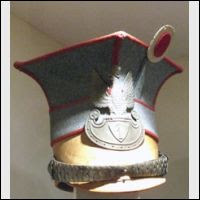 |
| Czapka of a wachtmeister of 1st Uhlan Regiment of Polish Legion |
CZAPKA is the Polish word for a cap. It was the headgear of 19th century Polish cavalry and was quite high and consisted of a four-pointed cap emblazoned with the regimental insignia on the front. Sometimes feathers or rosettes were added.
 |
| painting of 19th century Uhlan |
| Polish Uhlans |
 |
| Polish Uhlans in riding formation 1939 Poland |
Polish Cavalry Officer (1939)
01 wz.1935 "rogatywka" garrison cap
 |
| Polish Cavalry Officer - Lt. Col Władysław Anders before 1939 |
03 round cap of the 3rd Cavalry Regiment
04 wz.1937 "rogatywka" field cap
05 wz.1936 officers' garrison jacket,
insignia of the 6th Uhlan Regiment on collar tabs
06 memorial badge of the 21st Uhlan Regiment
07 dog tag
08 wz.1936 officers' field jacket
09 9mm wz.1935 "Vis" pistol
10 personal dressing
11 wz.1936 officers' main belt
12 leather holster for the wz.1935 pistol
13 officers' boots with spurs
14 officers' field bag, B-type
15 binoculars
16 strap for wz.1935 pistol
17 wz.1921/22 officers' sabre
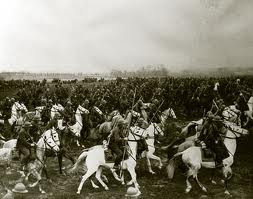 |
| Polish Cavalry - maneuvers before outbreak of WW2 |
Private, 1st Grenadier Division, Polish Army in France (1940)
 |
| Polish soldiers Camp Coetquidan, France1940 |
02 Model 1918 French forage cap
03 French Model 1915 "Adrian" helmet
04 Polish "rogatywka" cap
05 ammo clip
06 ammo pack
07 leather webbing
08 Model 1916 ammo pouches
09 Model 03/14 main belt
10 8 mm Berthier 1892 carbine
11 Model 1938 privates' jacket
12 Model 1922 trousers
13 Model 1935 gas mask with leather bag
14 calendar
15 Model 1893 backpack
16 blanket
17 Model 1935 mess kit
18 Model 1935 cup
19 canteen
20 Model 1917 boots
| Hieronim Dekutowski in Polish Army, France 1940 |
| Hieronim Dekutowski- Polish Army WW2 |
Hieronim Dekutowski (noms de guerre "Zapora", "Odra", "Rezu", "Stary", "Henryk Zagon") was an Officer of the Polish Armed forces fighting in the Western front, and was a legendary Cichociemni and guerilla commander of the Armia Krajowa (Home Army). After the so-called "Soviet liberation" of Poland, Dekutowski went into hiding from the Soviet NKVD and Urząd Bezpieczeństwa (UB). On February 5, 1945, Abram Tauber, the Jewish commander of the UB in Chodel invited four members of the Polish underground to his headquarters. Tauber had previously been rescued from the Nazis by Polish AK units, and often sought refuge at the "Zapora" compound. But when the Polish men arrived at the station Tauber ordered them to be tied up and single-handedly shot them one after another. In retaliation, Dekutowski attacked and destroyed the UB station in Chodel. The incident sparked an anti-Soviet uprising in the region.
Private, Polish Army in the USSR (1941)
01 wz.1937 "rogatywka" field cap
02 Model 1937 overcoat
03 main belt
04 Model 1904 ammo pouches
05 felt boots
06 tarpaulin gloves
07 7,62 mm Tokarev SVT-40 rifle
01 wz.1937 "rogatywka" field cap
02 Model 1937 overcoat
03 main belt
04 Model 1904 ammo pouches
05 felt boots
06 tarpaulin gloves
07 7,62 mm Tokarev SVT-40 rifle
 |
| Polish Army in USSR 1941-42 |
 |
| Polish Army parade at Buzułuku - USSR December 1941 |
| Military exercise in Polish camp at Tockoje- Russia 1941-1942 |
| General Anders and General Sikorski at reviewing stand inspecting Polish troops in USSR 1941 |
 |
| F/0 Miroslaw Feric -Ace Pilot |
01 RAF officer's cap with Polish wz.1936 air force eagle
02 RAF officer's jacket, Polish major insignia on the collar
tabs, British Flight Lieutenant insignia on the sleeves.
03 Officers' trousers
04 Shoes
05 Briefcase
06 Silver Cross of the Virtuti Militari Cross
07 Infantry Officer's School Badge
08 Observer badge
09 British Navigator's wings
 |
| Polish Ace Pilots - Jan Zumbach on the left |
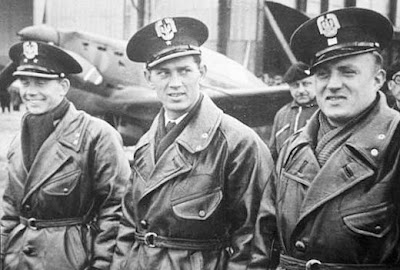 |
| Polish Pilots - France 1940 |
 |
Division 315 ‘Dębliński’ - Aug 14, 1942 Divisional Day (UK)
|
 | ||
| Polish 301 Bombing Division |
Photo: (Aug 20, 1940) Bramcote, UK. Officers inspecting Polish bombing squadrons in formation.
First row L-R; Lieutenant Colonel Roman Rudkowski-the first commanding officer of the Division 301, General Władysław Sikorski, King George VI, and Captain A. Davidson, Station Leader.
 |
| General Sikorski awards Silver Cross of Virtuti Militari to ace pilot Jan Zumbach Dec. 23, 1940 |
 |
| Polish Pilots (background is famous the PZL 37 Los Polish bomber ) |
 |
| Polish Ace Pilots - Kosciuszko Squadron-Battle of Britain 1940 |
 |
| GENERAL WLADYSLAW SIKORSKI |
 | ||||
| Polish Soldiers Battalion Chlopskie |
Partisan of the Peasant Battalions (Bataliony Chlopskie) Poland 1942
01 wz.1937 "rogatywka" cap
02 jacket
03 trousers
04 boots
05 improvised armband
06 9 mm MP-40 SMG
Bataliony Chlopskie was a resistance movement and partisan organisation created in the mid 1940s by
the Stronnictwo Ludowe, (Polish People's Party), an agrarian political party. By 1944 it was partially integrated with the Armia Krajowa (Home Army). At its peak it had 175,000 members. Their first major action was during the Zamosc Uprising in 1942 when the Germans expelled the Poles, expropriated their farmland and and gave it to German settlers. After several major battles, the Germans stopped the expulsions.
Major, 1st Polish Armoured Division (UK) 1942-43
 |
| 1st Polish Armoured Div - Regimental Day |
02 British officer's jacket
03 British trousers
04 Officer's belt
05 Shirt and Tie
06 Officers' boots
07 Black shoulder strap of 1st Armoured Div
08 1st Armoured Division Badge
09 Banners of 1st Independent HMG Batallion
10 1st HMG Batallion's honorary cord
Photo: Haddington 29.04.1943 The colour of the 10th Dragoons during the celebrations of the regimental day of the 10th Mounted Rifles.
 |
| July 1944 England 1st Polish AD in training |
 |
| (L) General Stanislaw Maczek |
 |
| General Stanislaw Maczek |
2nd Lt, 1st Infantry Division, Polish People's Army (USSR) 1943
 |
| 1st Polish (Peoples) Army Parade January 19, 1944 |
02 Model 1936 drill jacket, wz.1943 military
eagle on the buttons
03 Soviet breeches
04 Model 1935 officer's belt
05 synthetic leather holster for Nagant revolver
06 synthetic leather map pouch
07 leather boots
08 Adrianoy compass
09 binoculars
10 7,62 mm PPSh-41 SMG
11 decorations: Cross of the Valorous,
"Zasluzonym na Polu Chwaly" medal
 |
| Polish People's Army |
Polish soldiers of the 24th Self-Propelled Artillery Regiment.
(Vehicle may be an SU-85) Polish eagle moderated.
 |
| Polish soldiers of the 1st Tadeusz Kościuszko Infantry Division-Soviet backed July 28-30 1943 |
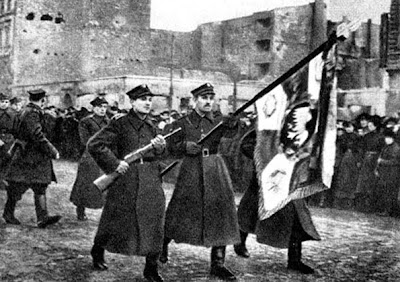 |
| Polish soldiers of the Soviet backed 1st Polish Army Jan 1945 so-called liberation of Warsaw |
 |
| Polish soldiers in Berlin May 1945 |
 |
| Zoska Battalion Warsaw Uprising |
Soldier of the Warsaw Uprising 1944
01 German "Gladiator" helmet
02 Wehrmacht sweatshirt in "Sumpftarnmuster" camp
03 Polish wz.1933 main belt
04 Polish breeches
05 German pre-1939 boots
06 Ak (Home Army) armband
07 9 mm Sten Mk II SMG
08 German ammo pouches for MP-38/40 mags
Photo of Zoska Battalion: Left to Right: Polish resistance fighters Wojciech Omyla, Juliusz Bogdan Deczkowski, and Tadeusz Milewski in captured German uniforms and Kar98k rifles, Warsaw, Poland, 5 Aug 1944.
 |
| Polish scout Warsaw Uprising |
 |
| Polish Scouts Armia Krajowa Warsaw Uprising 1944 |
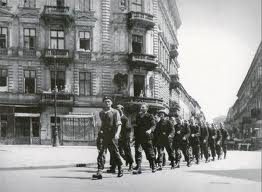 |
| Polish Insurgents column - Warsaw Uprising 1944 |
 |
| Home Army - Warsaw Uprising |
Lieutenant, 1st Polish Airborne Brigade, Arnhem 1944
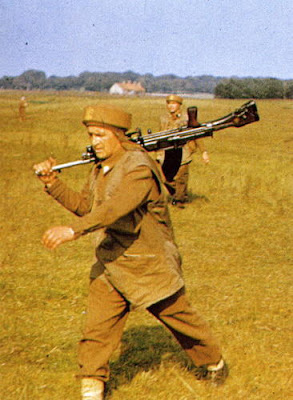 |
1st Polish Independent Parachute Brigade # 5 |
01 British beret with Polish eagle and rank insignia
02 "Denison smock" Mk I Jacket
03 "Oversmock" vest
04 Officers' boots
05 trousers from M37 Battle dress
06 British map pouch
07 captured German ammo pouch
used as a cover for a flashlight
08 webbing, belt and holster for
Enfield No2 revolver
09 9mm Sten Mk II SMG
10 AT Mk II airborne helmet
 |
| Standard 1st Polish Parachute Brigade |
Polish paratroopers during field exercises Scotland, Kingcraig circa 1943. These men were elite special operations troops who were called "Cichociemni" the dark and silent ones. Of 2,413 candidates, only 605 men were able to complete the training successfully, but 579 qualified for air missions.
 |
| Cichociemni in training (elite special operations Polish paratroopers) |
 |
| Paratroopers of the 1st Polish Independent Parachute Brigade - Market Garden |
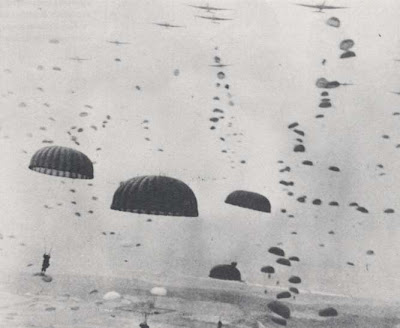 |
| Allied Paratroopers and 1st Polish Independent Parachute Brigade - Market Garden |
 |
| Field Marshall Montgomery inspect 1st Polish Independent Parachute Brigade |
 |
| General Stanislaw Sosabowski at Driel (Battle of Arnhem) |
General Stanislaw Sosabowski
Commander of the 1st Polish Independent Parachute Brigade
Private, 1st Polish Army, Kolberg March 1945
01 wz.1937 field "rogatywka" cap
02 Soviet M 1940 helmet with Polish wz.1943 military eagle
03 Model 1937 overcoat
| Kolberg 1945 |
05 M 1935 drill trousers
06 owijacze (leggings)
07 Soviet main belt
08 boots
09 German M-09 ammo pouches
10 pot
11 self-made spoon
12 7,62 Mosin 1891/30 rifle with bayonet
13 F-1 grenade
14 RPG-1 anti-tank grenade
15 oiler for the Mosin rifle
16 Maxim HMG ammo belt container
17 canteen
 |
| Polish soldiers - Kolberg 1945 |
Major, maintenance units of the 1st Polish Armoured Division (Germany 1945)
01 M 37/40 battle dress, maintenance units banners on the collar tabs
 |
| 1st Polish Armoured Division |
03 1st Arm Div badge
04 Silver Cross of the Virtuti Militari Cross
05 M 37 webbing
06 11,43 mm Colt M1911 pistol
07 Officers' boots
08 leather vest
09 drivers' gloves
10 armoured units' training helmet
11 AT Mk II motorcycle helmet
12 Mk II helmet
13 leggings
Photo at right: the 10th Mounted Rifles Regiment at Haddington 29.4.1943. Regimental Day
 |
| 1st Polish Armoured Division Aug 1944 (Sherman Tank) |
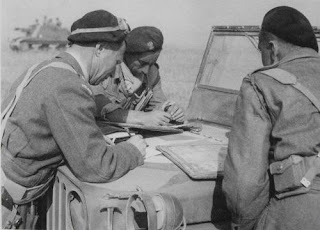 |
| 1st Polish Armoured Division 1944 (Normandy) |
 |
| 1st Polish Armoured Division |
Polish Navy
 |
| Presentation of new Polish Naval Officers to President on Oct 15, 1936 Warsaw Castle |
 |
| Polish sailors in UK 1943 |
 |
| Illustration of Polish sailor's uniform WW2 |
 |
| King George VI reviews Polish naval regiment (UK) |
| Polish Naval Commander RearAdmiral Jozef Unrug (1930 ranked Captain) |
 |
| Jozef Unrug Polish Vice Admiral |
 |
| 2nd Polish Corps with Wojtek the cub bear |
01 M40 battle dress, AAA colors of the collar tabs
02 American woollen shirt
03 M40 overcoat
04 M42 beret
05 boots
06 M37 breadbag
07 dog tags
08 ribbons of the Monte Cassino Cross
09 2nd Polish Corps Artillery memorial badge
10 Polish-English pocket dictionary
11 Propaganda leaflet
 |
| Official Emblem Wojtek |
Wojtek was more than a mascot. He grew up to become an official soldier of the 2nd Polish Corp - the 22nd Artillery Supply Company. He carried heavy loads of ammo for his unit.
 |
| Polish Soldiers 2nd Polish Corps Monte Cassino, Italy 1944 |
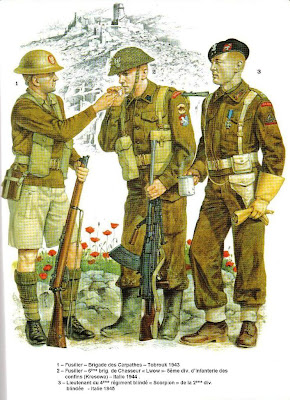 |
| An Illustration of soldiers of 2nd Polish Corps Monte Cassino Italy |
 |
| Soldiers of 2nd Polish Corps charging up Phantom Hill - Monte Cassino |
 |
| General Anders salutes soldiers of 2nd Polish Corps |
 |
| General Wladsylaw Anders - Commander of 2nd Polish Corps |
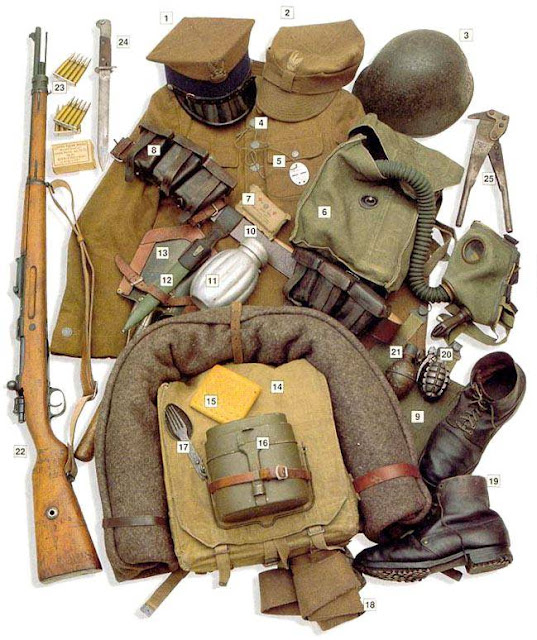

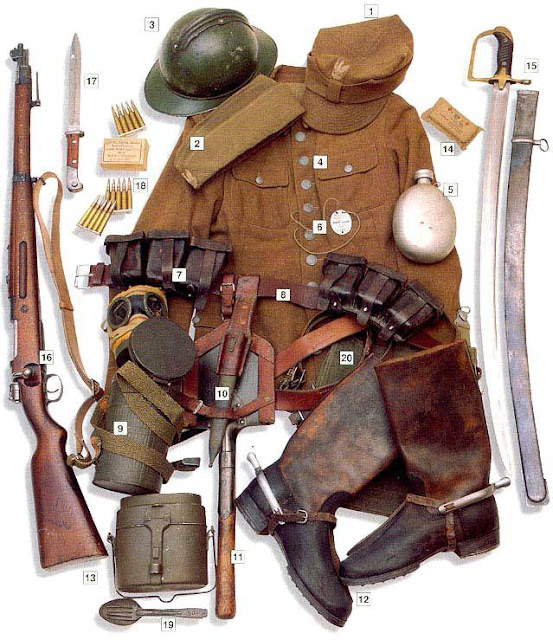








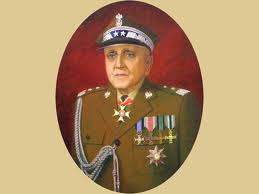


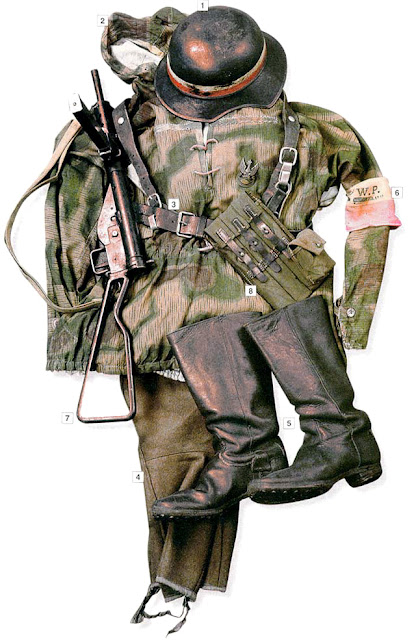
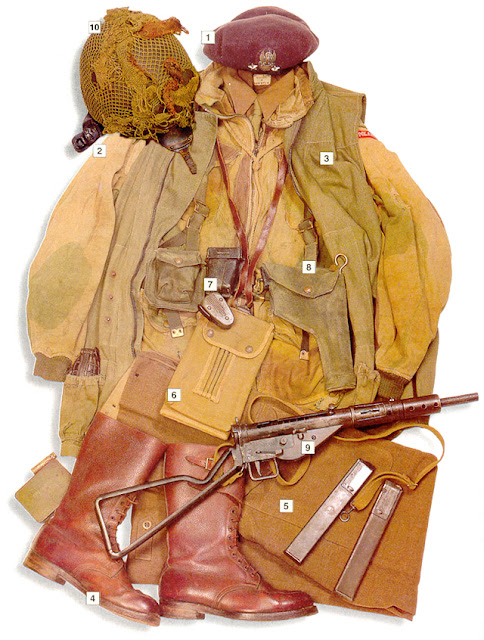





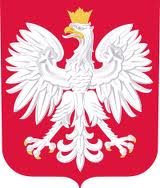
Polish friends will willingly talk about the war and, if they are old enough, their personal recollections, but tend to be less forthcoming about the period from 1944-1956. I understand why.
ReplyDeleteI am learning a great deal from your posts, which are full of new (to me) information.
Thank you again!
Thank you again for your comments! I am so pleased to know that you find my blog posts interesting! It is encouraging to know that Polish youth is openly discussing the war, but I hope that they realize the extent of Polish contributions to the allied war effort. Sadly, the West all to often overlooks or undermines Poland's role during WW2. I can understand the reticence of Polish Veterans in discussing the war but we cannot even imagine the terror that they experienced under German and Soviet occupation, and the complete destruction and devastation they lived through. Still, I hope that some of these Polish men and women will write about it. Their stories need to be told, and stand as testament to history. Their silence would be a greater tragedy.
DeleteHello! I randomly fell across your blog on my quest to discover more about the photographs of my grandfather and other soldiers who were part of the Polish army during WWII. As a result of the information and images in your blog, I have been able to discover what the uniform my grandfather wore actually looked like (In colour!).
DeleteAs part of our photo collection we also have a few pictures of other members of the Polish Army. As my grandfather is no longer with us, he could not tell us himself who these men were and what each part of their uniforms meant. So, in conjunction with information in Wikipedia about ranks and insignia, your site has enabled me to formulate a background for the men in these photos - purely based on their uniform. I cannot thank you enough!
Thank you for your comments! I am very pleased to know that my blog has been helpful to you in your quest! If you have not already done so, may I suggest that you contact your local office of the Polish Veteran's Society, Polish Library, or log onto the Polish State Archives. They will most certainly provide you with ample information and resources. Good luck in your search, and Best Regards!
Deletelet your neighbors to the north keep their gas,keep your own forces strong
ReplyDeleteI just stumbled on your blog and I have to say I have found it very interesting indeed. When I was young I remember my Grandfather telling me about a Polish naval destroyer that was anchored off of Portsmouth, UK during the war. When the Germans were attacking the dockyard during the blitz the brave Polish crewmen of this ship gave their all in defending the British people and I believe they were all awarded with bravery medals by the king. I think that we in the West should be ashamed of our conduct after the war when we turned our backs to the fate of this proud nation. Your blog is wonderful and at least some of us have not forgotten the debt we owe..... Tim
ReplyDeleteThank you for your comments, and thank you so much for sharing such an inspiring story! Polish heroes will never be forgotten! Best Regards.
DeleteI am a re-inactor wishing to work up a uniform for a Polish Military police officer and require a Police duty bage and a breast badge.Everything els I can obtain. Does anyone know where I can these items at not to high a price I hope as I am a pensioner.Reproductions are quite acceptable.
ReplyDeleteHi, very interesting blog, just one little correction, there is a mistake in the description of the colour pictures showing podhale rifles, they are not reenactors but real polish soldiers...
ReplyDeleteThank you for your comments. You are indeed right! They are real Polish soldiers! I will correct the descriptions. And thank you again for notifying me. Best Regards.
DeleteWhat a great site.
ReplyDeleteYou are rightly proud of the Polish forces!
I am running an all age research project in during 2013 exploring the anti airborne invasion defences around Dunfermline,Fife, Scotland.
Polish troops were involved and billeted there.
So far I have only one name: G. Krzywicki P/9 Polish Forces.
On 6/12/42 He sent a postcard from Dunfermline to: Mrs Wheatley 51 Glebe Cres. Tayport. Fife
Any help in finding out who dug and manned the trenches, built and manned the road blocks I have been finding recently would be very welcome.
On 16th Feb we have a public event in the Pavilion where the Polish troops were billeted and we would love to host some Polish veterans and family members.
Thanks again.
Roger Pickering
office@forthpilgrim.org
Thank you for creating and hosting this site. My father served in the Polish 2nd Corps throughout the Middle East and Italy. My mom was a survivor of the Nazi occupation and participated in the uprising. Both had many near death experiences before being reunited in a displaced person's camp in England.They lived to be 96 each and married for 69 years!I am in the process of writing their story. It's a slow process because of lack of good information in English regarding the Polish 2nd Corps and because it is still a very emotional thing for me. Dziekuje bardzo. Tereska Buko
ReplyDeleteThank you for your comments. Your parents were truly heroes, as were all Polish fighters during WWII. It is for them that I dedicate this blog and my website, Polish Greatness.com I encourage you to write about their stories, so that their sacrifices will be forever recorded in history. If you have not already read it, please check out the book written by General Wladyslaw Anders,(in English) entitled, "An Army in Exile: The Story of the Second Polish Corps" (You can purchase it from Amazon.com)
ReplyDeleteMay I suggest reading the newly-published book "The Eagle Unbowed - Poland and the Poles in the Second World War" by Halik Kochanski. It is a harrowing account of what Poland and the Polish people had to go through during that fateful time. Being of Polish extract 100%, I strongly recommend it.
ReplyDeleteThank you very much Anonymous for your suggestion! I am sorry to admit that I have not read it, but I most certainly will now!
ReplyDeleteThank you for the blog. I am a Canadian and son of a WW2 Polish Vet. My Father Kazimerez Klimaszewski, fought in 1939 in the 18 th. Infantry Division. He spent from October 1939 to December 1944 as a POW in Germany. He escaped for the third time during the Battle of the Bulge and presented himself to General Patton's advanced guard. Regaining his freedom he joined the 2nd Polish Corp until the German surrender. Relocating to Canada in 1948 he founded the Polish Combatants Association of the tens of Thousands of Polish Vets in Canada. Using this organization as a platform he devoted himself to his clear duty for the next 43 years: the freedom of Poland and the confounding of the Soviet Union. The greatest moment of his life was with is old army buddies marching in Warsaw returning their Army Unit Battle Flags to a free Poland in the early 1990's. Be at peace father and rest now, all honor is restored. One day I will return your ashes to Powonski Cemetery in Warsaw...Markek.
ReplyDeleteHi, just a moment back I was searching for the information on military clothes and now I am here. So much information, really well executed blog. This is really informative and I will for sure refer my friends the same. Thanks
ReplyDeleteHi there,
ReplyDeleteSome friends of mine found this item while metal-detecting on the Hel Peninsula. Can anyone identify it? It's made of leather with metal fittings.
http://i525.photobucket.com/albums/cc339/brickiescavenger/Mysteryobject_zps4ee396d8.jpg
Thank you Brickie for your message. I am fascinated by the photo of the item you mention! But I am sorry I cannot identify it. Hopefully, one of my readers may be able to provide an explanation. Good luck in your search! Best Regards.
ReplyDeleteHello,
ReplyDeleteWhat a wonderful web site! The best yet.
I grew up in and round the port city of Southampton, Hampshire, southern England - where we grew up with a large and wonderful Polish community. The city was still pretty much a bomb site until 2005, when the last space of blitzed houses was finally redeveloped.
My Playschool(kindergarten) 'Jack and Jill' teacher Mary Barker, was a Polish lady married to a Polish Serviceman. From a tiny child (born 1967)I was made very aware of the contribution the Polish Forces had made to giving me the freedom to live my life - but also at the unimaginable sacrifice of their own country - betrayed as they were by the politicians of my own.
Many people in and around the city of Southampton continue to talk of the bravery and indomitable spirit of the Polish Free Forces and ensure the younger generations are made aware of the unimaginable sacrifices made for them. Many Polish surnames are very evident from those who came in exile, and stayed to become locals.
Apologies for going on a bit. As a Military Maritime and Aviation historian, I have worked within Museums and Archives, where the bravery and incredible feats carried out by the men and women of the Polish forces are remembered and discussed daily.
The Veterans who visit the Museums gift wonderful - and privileged - exchanges of information from their lives to us; knowing that we will impart it to others.
Over the years, a tireless force has assisted in writing life stories, collating photos and diairies, memoirs of pre-WW11 Poland and the very different, difficult life as an exile - with a great amount of recorded stories. No holds bared - the appalling and the wonderful incidents are there to be learned from.
A Spitfire pilot of my acquaintance told me that no one could touch the Polish airmen for bravery, incredible manoeuvres and being the epitome of gentleman daredevils. I believe that when you have lost all, you give all to reclaim it. Alas...
Here are a few of many websites of interest:
http://www.sikorskimuseum.co.uk/
http://www.dsh.waw.pl/en/oral_history_archive/17
http://www.rafmuseum.org.uk/research/online-exhibitions/the-polish-air-force-in-world-war-2.aspx
http://www.swmaritime.org.uk/forums/thread.php?threadid=99
http://polishgeno.com/?page_id=12
http://www.ceelbas.ac.uk/ceelbas-news/events/workshops/polish-exile
http://www.polandinexile.com/
My deepest respects to Witold Chomicki, who fought in the Western Desert, all the way through Italy and became an exile in Britain; passing away at the age of 95 on the 9/8/13. WE WILL REMEMBER THEM.
Thank you, Sir, for your wonderful comments about Polish people! It is extremely rewarding for me to encounter such positive responses, and to feel assured that there are communities around the world which are very knowledgeable and appreciative of the sacrifices made by Poland during and after WW2. This recognition and respect does much to heal the soul of the Polish nation and the spirit of Polish people everywhere.
ReplyDeletePlease do not apologize for the length of your comment - I have enjoyed reading it. I do appreciate your comment about my blog and I am honoured. I commend you greatly, Sir, for your commitment and work to preserve the stories of the past, so that future generations will not forget. You are indeed fortunate to meet some of the Veterans - men (and women) of exceptional calibre. I have written extensively about the lives and contributions of great Polish heroes of WW2, including the amazing Polish pilots of the RAF.
Thank you for providing URLs of some very important websites. I am sure that my visitors/readers will find them very helpful in their research.
Though our heroes pass away, their spirits continue to live on in our hearts and minds. We will remember their sacrifices, their courage, and their motto: For Your Freedom and Ours.
Best Regards
What a superb website. Thank you very much. I am trying to trace two Polish servicemen who were in the Perthshire area during WW2. Probably from 1945 to 1947. I have photos of them and will try and establish from your photos of uniforms what company they were serving in. Do you know if records were kept for these servicemen and if so, could I get access to them? It is very important to me and I wish I had started searching much earlier. Kindest regards and best wishes.
ReplyDeleteThank you for your comments. The best source for information on military records of Polish servicemen, would be the Ministry of Defense, APC Polish Enquiries, in England. For contact details of this and many other sources, please read my blog, entitled, "Polish Greatness: Researching your Polish Roots". (February 2013)
ReplyDeletehttp://polishgreatness.blogspot.ca/2013/02/polish-greatness-researching-your_9.html In some cases, you may be required to provide proof of kinship to gain access to information. Please do not be discouraged, and do call and speak to them directly. Incidentally, I am planning another blog post this year on the subject of Polish WW2 uniforms and will provide many more illustrations that will be of great interest. Wishing you success in your research. My Best Regards.
Hello there,
ReplyDeleteThanks for the great pics and information.
My father was a cavalery officer (DSP) during wwii, and he told me various things about his uniform. But unfortunately could not find someone to make a good reproductions. Could you help me to find a good one
Hello Sir, Thank you very much for your comments about this blog post! It is a great honor that your father was a cavalry officer (DSP) in World War II. I do not know anybody personally who could reproduce these uniforms. But may I suggest you contact the administrator of the following link, which belongs to the WW2 Polish Army Historical Association. I am sure somebody can give you referrals. Please copy and paste this URL in your browser. And good luck in your search! http://12lancers.com/index.php
ReplyDeleteSuch a moving reading about the Polish soldiers. My husband's brother in law - Jakub Bruen (31166 Lance Corporal) served with Polish Land Forces Abroad (under British Command) from September 1941 to May 1948. He received 4 medals. He wore an army band with yellow round badge in the middle. I would like to know if the upper band should be white or black and the bottom band should be red? Please clarify for me with a grateful thanks.
ReplyDeleteHello Valerie. Thank you very much for your message. I enjoy receiving feedback and information from my readers! I would be very interested to see a photograph of the armband you mentioned. If you can email it to me at polishgreatness@gmail.com I will check with my sources and reply to you as soon as possible. Thank you again for your interest in my blog posts! Best Regards
ReplyDeleteAn informative site. I have a Polish uniform that I cannot identify. Can I send you pics? The cap has a black band and 4 stars as does the shoulder straps. I am told it is for a civilian though.
ReplyDeleteHi, very interesting blog, Lately I spent so much time read the fascinated stories .Thank you , we will never forget them.. God bless you.
ReplyDeleteGreat site with ref to Poles in ww2 my father who i have been collecting information on was in the 1st armoured regt and died on hill 262 at the BATTLE OF FALISE in Normandy on the 20th august 1944 i was 7 months old at the time i recieved a lot of info from a gentleman in London who gave me some help he was Mr STANISLAW GRABOWSKI an officer in the same regiment he gave me information with ref to the yearly rememberence on hill 262 at Coudehard in normandy which attended some years ago which was a very moving experience, the said genleman has since passed away god rest him if any one is interested i have some photos taken on my visit i intend to make one more return if health permits next august my father had emigrated to Argentina in 1929 as many Poles did in those pre war years, but when called upon to help free there country returned to Britain to help but it never was freed in fact i did not know that on the V.E parade in London the only troops that did not take part was these brave men as they had no country my father and his comarades are remembered on a meorial to the 1st and 2nd armoured regt,s in Duns park on the eastern Scottish border,s i am now trying to locate a book recently translated from french to english with ref to hill 262 in august 1944 any help would be appreciated i recieved a couple of photos and his medals from the Polish war office but presume may have closed down now i am still looking for regt,ll photos will purchase if any one has any thing with ref toTHE 1ST+2ND POLISH ARMOURED regts Mick c.
ReplyDeleteGreat blog! Very informative. Is there a way to find out the colors for the colar tabs used by the 1st Polish Armoured Division in Holland early 1945? Each regiment had its own colors on their battle dress tabs but I haven't found an overview yet. Especially am interested in the smaller units like the MP company, etc. Cheers, André
ReplyDeleteFeel free to contact me at a.g.jans[at]home.nl
My father was a paratrooper during Market Garden and I am trying to find information about his service. He passed away in 1980 and I have only sketchy information from my mom. I do have a picture of him in uniform I can scan and send to anyone knowledgeable enough to decipher his rank, etc. He traveled from Siberia to join Polish Army in Middle East I believe. He lived in Scotland for a few years after the war before coming to US and settling in New Jersey. Born in 1925. Any information would be greatly appreciated as I am obviously of Polish descent and very interested in learning all I can about my dad and all the brave Poles during ww2. Please email me at 1968tigger@comcast.net.
ReplyDeleteThank you Marie for your comments, and sharing your story! The Warsaw Uprising has been shrouded in history for too long and the time for revelation is now. The public has always seemed to be enthralled by fictionalized stories of historical events. But as long as historical facts are not comprised in the process, then I fully support any literary endeavor! I congratulate you for your efforts and commitment to publicize a very important era in Polish history. I wish you continued success! My Best Regards!
ReplyDeleteHello, would you be able to identify a military branch by a uniform? I do not see my grandfather's uniform on here, but I have a photo of him from WWII. Would be so amazing if you can help. Thanks! -Curtis
ReplyDeleteHello, congratulations on a very good and useful site, very informative.
ReplyDeleteBorn and raised in Roeselare - Belgium my father told me that the city was liberated by the Polish on 16/09/1944.
For my job, I moved to Stekene and noticed that the area between Terneuzen and Antwerp was liberated by the Polish.
Just over the Dutch border, in Axel is a Polish museum about the liberation.
I try to complete a Polish Dispatch Rider uniform and I noticed on the above pictures that the Motorcycle Riders had a standard issue British but black helmet.
I suppose this is also the case for the Dispatch Riders also because of the black berets.
Do you know if the Dispatch Riders rode BSA or another British brand?
Do you know where I can find pictures of DR's with the motorcycle and where I can buy the insignia?
I want to show in Normandie that Poland (and Belgium) took also part in the war and not only the AA ...
Thanking you in advance,
Filiep Depuydt
filiep.depuydt@gmail.com
Hi - I'm looking for information about the Polish Brigade stationed at Castle Camp Pickering North Yorkshire 1940 - 1956. Name of Brigade and regimental badge etc would be very helpful.
ReplyDeleteThere seems to be zero info. about the unit. Thank you.
Awesome info, thanks!
ReplyDeleteGreat side!! A question, i've been looking for some info, photos, drawings about the battle dress collar patches and the sleeve patches of a common soldier off the 1st Polish Armoured Regiment in the time when there ar in the Netherlands 1944/1945. I mean the whole battle dress. Not just the patches itself but on the battle dress. I hope that i get some answeres here. Thanks.
ReplyDeleteMuy buena información, felicitaciones por el foro. Es de gran utilidad para quienes nos interesamos en los eventos que participo nuestra familia. En mi caso, mi abuelo fue parte del segundo cuerpo polaco y como enfermo y falleció joven, no tuvimos oportunidad de conocer bien su historia. Estoy investigando hace años y hace muy pocos días, recibí unas condecoraciones de Reino Unido que nos llenan de orgullo, Sigo adelante buscando para lograr reencontrarnos con su pasado glorioso. No logro aun llegar a documentación militar polaca, con su información pude ver el uniforme y en esta pagina las condecoraciones que corresponden a su compañía. No bajo los brazos, Gracias!
ReplyDelete